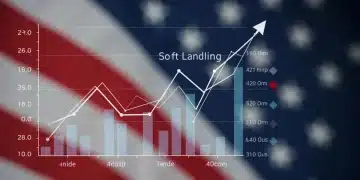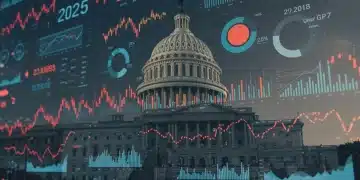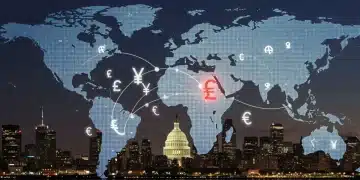Rising Energy Prices: Impact on US Economy in 2025

Expected increases in energy costs in 2025 will significantly pressure US economic sectors, elevating production expenses, impacting transportation networks, and subsequently influencing consumer purchasing power and overall market stability.
The year 2025 is shaping up to be a pivotal period for the United States economy, with forecasters pointing to significant shifts driven by energy market dynamics. Understanding how rising energy prices are affecting key sectors of the US economy in 2025 is crucial for businesses, policymakers, and consumers alike. This article delves into the anticipated impacts, offering a comprehensive look at the challenges and potential adjustments across various industries.
Understanding the Drivers Behind 2025’s Energy Price Hikes
The anticipated surge in energy prices for 2025 isn’t a singular phenomenon but rather a confluence of several global and domestic factors. Geopolitical tensions remain a primary catalyst, with conflicts and instability in major oil-producing regions directly influencing supply chains and market sentiment. Furthermore, the global push towards decarbonization, while essential for long-term sustainability, often involves transitional costs that can temporarily elevate fossil fuel prices due to reduced investment in conventional extraction methods.
Domestically, evolving regulatory landscapes and infrastructure challenges also play a significant role. The balance between meeting current energy demands and investing in renewable technologies can create market volatility. These factors collectively contribute to an environment where energy costs are likely to trend upwards, impacting the foundational elements of the US economy.
Global geopolitical factors
Ongoing international conflicts and political instability in key energy-producing nations create significant uncertainty in global oil and gas markets. Disruptions to shipping routes or production facilities can lead to immediate price spikes. Additionally, sanctions and trade disputes between major powers further complicate supply dynamics and increase the cost of energy imports.
- Supply chain vulnerabilities from conflict zones.
- Impact of international sanctions on energy exports.
- Increased demand from emerging economies.
- Strategic energy reserves and their influence on pricing.
Domestic policy and infrastructure
Within the United States, energy policies and the state of infrastructure are critical. Investments in new pipelines, refining capacity, and grid modernization directly affect the efficiency and cost of energy delivery. Environmental regulations, while necessary, can also impose costs on energy producers, which are often passed on to consumers. The transition to cleaner energy sources requires substantial investment, and the pace of this transition can influence traditional energy prices.
Understanding these underlying drivers is the first step in comprehending the widespread economic ramifications. The complex interplay of global events, domestic policies, and market forces will define the energy cost landscape in 2025, setting the stage for significant challenges across various sectors.
Manufacturing Sector: Navigating Higher Operational Costs
The manufacturing sector stands as one of the most vulnerable to rising energy prices. Energy is not merely a utility; it’s a fundamental input in almost every stage of production, from powering machinery to heating and cooling facilities. As energy costs climb, manufacturers face a direct increase in their operational expenses, squeezing profit margins and potentially leading to higher consumer prices for finished goods. This ripple effect can diminish competitiveness, particularly for industries that are highly energy-intensive.
Companies are already exploring various strategies to mitigate these impacts, including investing in energy-efficient technologies and optimizing production processes. However, these solutions often require significant upfront capital, posing a challenge for smaller businesses. The ability of manufacturers to absorb or pass on these increased costs will largely determine their resilience in 2025.
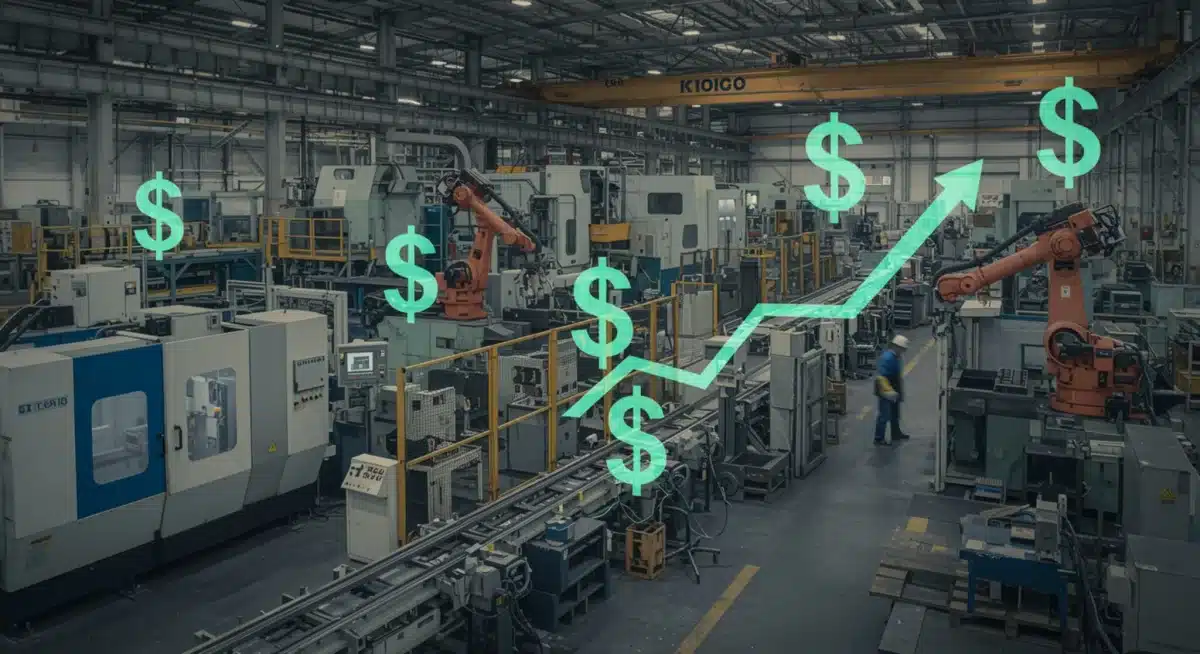
Increased production expenses
For many manufacturing processes, energy represents a substantial portion of total operating costs. Foundries, chemical plants, and heavy machinery producers, for instance, rely heavily on electricity and natural gas. When these costs rise, the direct expense of producing goods escalates, forcing companies to make difficult decisions regarding pricing, production volumes, and investment in new technologies. This can lead to reduced output or even relocation of production facilities.
- Raw material processing costs increase.
- Operational budget strain for energy-intensive plants.
- Potential for reduced production output.
- Pressure on profit margins and investment capacity.
Impact on supply chains and competitiveness
Beyond direct production costs, rising energy prices affect the broader supply chain. The cost of transporting raw materials to factories and finished products to market increases, adding another layer of expense. This can make domestically produced goods less competitive compared to imports from regions with lower energy costs, potentially leading to a shift in consumer preferences and market share. Businesses may also face challenges in maintaining inventory levels due to higher logistics costs, impacting overall supply chain efficiency.
In conclusion, the manufacturing sector in 2025 must confront significant challenges posed by escalating energy prices. Adaptability, through technological upgrades and strategic adjustments to supply chains, will be paramount for maintaining profitability and market position. Companies that can effectively manage their energy consumption and diversify their energy sources will likely fare better in this evolving economic landscape.
Transportation & Logistics: Fueling Higher Costs for Goods Movement
The transportation and logistics sector is inextricably linked to energy costs, making it particularly susceptible to price fluctuations. Every form of goods movement—trucking, shipping, rail, and air cargo—relies heavily on fuel. As rising energy prices take hold in 2025, the cost of transporting everything from agricultural products to electronics will inevitably increase. This directly translates to higher operational expenses for logistics companies, which are then typically passed on to businesses and ultimately to consumers.
This sector’s response will involve a multi-pronged approach, including fuel efficiency initiatives, route optimization, and potentially exploring alternative fuels. However, the immediate impact will be felt through elevated shipping rates and longer delivery times as companies strategize to contain costs. The efficiency of the entire supply chain hinges on stable and affordable energy, and any disruption here has widespread economic repercussions.
Freight and shipping expenses
Fuel is the lifeblood of the freight industry. For trucking companies, airlines, and maritime shippers, even marginal increases in fuel prices can significantly impact their bottom line. These companies often operate on tight margins, meaning that sustained higher fuel costs necessitate price adjustments for their services. This leads to a cascading effect, where the cost of every item moved through the supply chain increases, contributing to inflationary pressures across the economy.
- Increased operational costs for fleets.
- Higher shipping rates for businesses.
- Potential for longer transit times due to cost-saving measures.
- Impact on perishable goods transport and freshness.
Supply chain resilience and inflation
The resilience of supply chains is tested when transportation costs spike. Businesses may seek to localize production or source materials closer to home to reduce shipping distances and expenses. However, this isn’t always feasible, leading to reliance on more expensive transportation. The cumulative effect of these increased costs across the entire supply chain contributes directly to inflation, making everyday goods more expensive for consumers and eroding purchasing power. Companies must strategically evaluate their logistics networks to minimize exposure to volatile fuel markets.
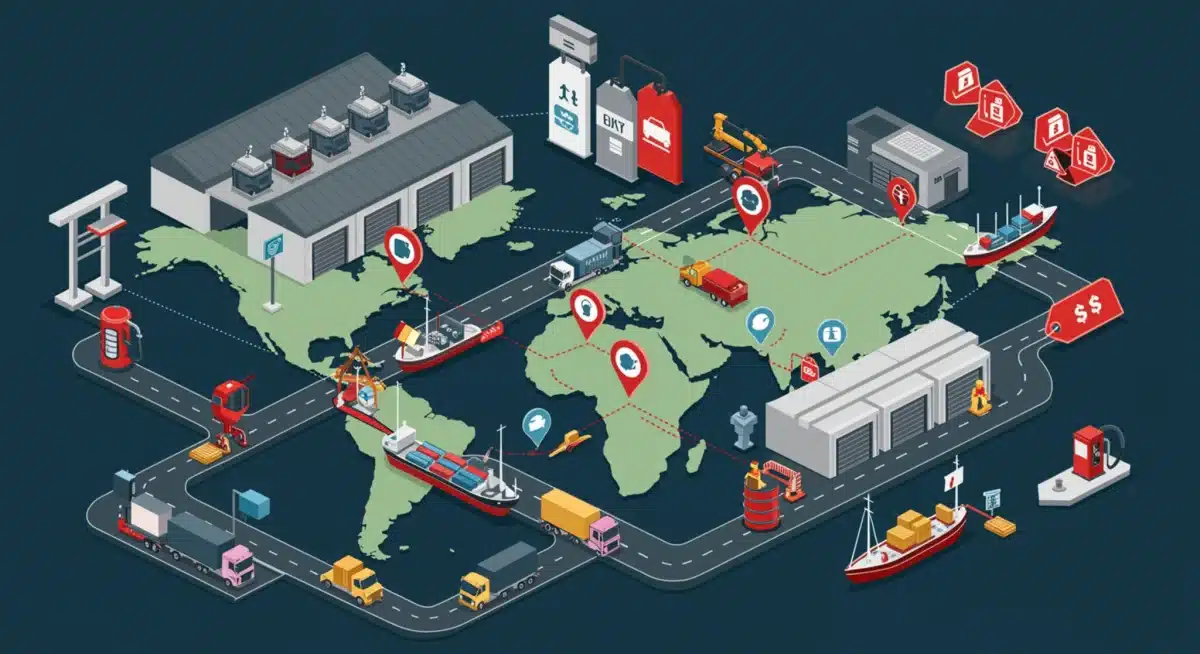
Ultimately, the transportation and logistics sector will be a critical barometer for the broader economic impact of rising energy prices in 2025. Its ability to adapt and innovate will be crucial in mitigating inflationary pressures and maintaining the fluidity of goods movement across the nation.
Consumer Spending & Inflation: A Direct Hit to Household Budgets
Perhaps the most immediate and tangible impact of rising energy prices in 2025 will be felt by American households through increased costs for essential goods and services. Higher prices for gasoline, electricity, and natural gas directly reduce disposable income, forcing consumers to adjust their spending habits. This shift can lead to decreased demand for discretionary items, impacting retail, hospitality, and other consumer-facing industries.
The inflationary pressure from energy costs is not limited to direct utility bills or fuel for vehicles. As discussed, higher energy prices translate to increased production and transportation costs for nearly all goods, meaning that the price of groceries, clothing, and even healthcare services will likely see upward adjustments. This creates a challenging economic environment where wages may not keep pace with the rising cost of living, leading to a decline in real purchasing power.
Erosion of purchasing power
When a significant portion of a household’s budget is allocated to energy expenses, there is less money available for other purchases. This reduction in discretionary spending can have a profound effect on various sectors of the economy. Retailers may experience lower sales, restaurants fewer patrons, and service industries less demand. For lower-income households, the impact is even more severe, potentially leading to financial hardship and increased reliance on social services.
- Reduced disposable income for families.
- Shift in consumer spending towards necessities.
- Decline in demand for luxury goods and services.
- Increased reliance on credit for essential purchases.
Behavioral changes and economic slowdown
Sustained high energy prices can also trigger behavioral changes among consumers. People may drive less, opt for public transportation, or reduce their overall energy consumption at home. While beneficial for environmental conservation, these shifts can also signal a broader economic slowdown. Businesses reliant on consumer mobility or discretionary spending may need to innovate or diversify to remain viable. The cumulative effect of these individual adjustments can contribute to a significant deceleration in economic growth, making 2025 a year of careful financial planning for many.
In essence, the consumer sector acts as the ultimate recipient of energy price shocks. Its ability to adapt and absorb these costs, or the lack thereof, will be a key determinant of the overall health and stability of the US economy in 2025. Policymakers will face pressure to implement measures that alleviate the burden on households while encouraging sustainable energy practices.
Agricultural Sector: Planting Seeds of Uncertainty
The agricultural sector, often considered the bedrock of any economy, is surprisingly susceptible to the volatility of energy markets. From planting to harvest, and from processing to distribution, every stage of food production is energy-intensive. In 2025, rising energy prices will directly impact farmers’ operational costs, affecting everything from fuel for tractors and irrigation systems to the cost of fertilizers and pesticides, which are often produced using natural gas.
This increased financial burden on farmers can lead to higher food prices for consumers, further contributing to inflationary pressures. Additionally, it could force some farmers to reduce crop yields or scale back operations, potentially impacting food security and the availability of certain agricultural products. The sector will need to explore energy-efficient farming practices and renewable energy solutions to build resilience against these cost pressures.
Farm operational costs
Farmers face a multitude of energy-related expenses. Fuel for machinery is a major cost, but so is electricity for operating pumps, ventilation systems in livestock facilities, and temperature control in storage units. The production of agricultural chemicals like nitrogen fertilizers also consumes vast amounts of energy. As these input costs rise, the profitability of farming operations diminishes, putting financial strain on producers and potentially leading to higher food prices for consumers.
- Increased fuel expenses for farm machinery.
- Higher electricity costs for irrigation and facilities.
- Elevated prices for energy-intensive fertilizers.
- Pressure on farm income and investment in modern equipment.
Food prices and supply stability
The direct consequence of higher agricultural production costs is an increase in food prices at the grocery store. This exacerbates the inflationary environment and places additional strain on household budgets. Furthermore, if farmers are unable to absorb these costs, they may reduce planting or livestock numbers, leading to potential disruptions in the food supply chain. Ensuring stable and affordable food supplies is a critical concern, making the agricultural sector’s response to energy price hikes a matter of national importance.
In summary, the agricultural sector in 2025 will navigate significant challenges from escalating energy prices. The adoption of sustainable and energy-efficient farming methods will be crucial not only for the financial health of individual farms but also for maintaining food security and managing broader inflationary trends within the US economy.
Utilities and Energy Producers: Balancing Supply, Demand, and Investment
For utilities and energy producers, 2025 presents a complex landscape shaped by rising energy prices. While higher prices might seem beneficial for producers, the reality is more nuanced. They face increasing costs for extraction, refining, and distribution, as well as pressure to invest in new infrastructure and cleaner energy sources. This sector is at the forefront of managing the delicate balance between meeting current energy demands and transitioning to a more sustainable future, all while navigating volatile market conditions.
Utilities, in particular, must contend with regulatory oversight that often limits their ability to immediately pass on increased costs to consumers, leading to potential financial strain. Their ability to secure stable and affordable fuel sources, invest in grid modernization, and expand renewable energy capacity will be critical for providing reliable and cost-effective energy to the nation.
Investment in infrastructure and renewables
The energy sector requires continuous, massive investment in infrastructure. This includes upgrading aging power grids, building new transmission lines, and developing renewable energy projects like solar farms and wind turbines. Rising costs for materials, labor, and financing—partially influenced by energy prices themselves—can slow down these essential investments. Delaying infrastructure improvements can compromise energy reliability and hinder the transition to cleaner energy, creating a vicious cycle.
- Challenges in financing new energy projects.
- Increased costs for grid modernization efforts.
- Slower adoption rates for renewable energy technologies.
- Need for policy support to incentivize infrastructure investment.
Regulatory challenges and consumer impact
Utilities operate under strict regulatory frameworks designed to protect consumers from excessive price hikes. While this is crucial, it can also create a lag between rising wholesale energy costs and the approved rates utilities can charge. This gap can squeeze utility profit margins, potentially impacting their ability to invest in necessary upgrades or maintain service quality. Ultimately, if these pressures become too great, rate increases become unavoidable, directly affecting consumer utility bills and contributing to overall household expenditure increases.
In conclusion, the utilities and energy production sector faces a critical period in 2025. Navigating the complexities of market volatility, regulatory demands, and the imperative for sustainable investment will determine its capacity to power the US economy effectively and affordably amidst rising energy price trends.
Policy Responses & Economic Outlook: Steering Through the Storm
As rising energy prices loom over 2025, policymakers in the United States will face considerable pressure to implement strategic responses that mitigate adverse economic impacts. The challenge lies in crafting policies that address immediate cost burdens on consumers and businesses, while also fostering long-term energy security and sustainability. A balanced approach will be essential to avoid exacerbating inflation or stifling economic growth.
Potential policy interventions could range from targeted subsidies for low-income households, tax incentives for energy-efficient technologies, to strategic investments in domestic energy production and infrastructure. The effectiveness of these measures will largely determine the overall economic outlook for the US in 2025 and beyond, influencing everything from employment rates to international trade balances.
Government interventions and subsidies
Governments often resort to various interventions during periods of high energy prices. These can include direct financial aid to households struggling with utility bills, gasoline tax holidays, or subsidies for industries heavily impacted by increased energy costs. While these measures can offer temporary relief, they also carry fiscal implications and can sometimes distort market signals. The judicious application of such policies will be crucial to ensure they provide necessary support without creating unintended long-term consequences.
- Targeted financial assistance for vulnerable populations.
- Temporary tax relief on fuel or energy consumption.
- Incentives for businesses to adopt energy-saving practices.
- Strategic release from national petroleum reserves.
Long-term energy strategy and innovation
Beyond immediate relief, a robust long-term energy strategy is paramount. This involves accelerating the transition to renewable energy sources, investing in energy storage solutions, and enhancing grid resilience. Encouraging innovation in energy efficiency and alternative fuels can reduce future reliance on volatile fossil fuel markets. Policies that foster research and development, alongside public-private partnerships, will be vital in building a more secure and sustainable energy future for the US economy, lessening its susceptibility to future price shocks.
In conclusion, 2025 will test the agility and foresight of US policymakers. Their ability to implement effective short-term relief measures while simultaneously advancing a coherent long-term energy strategy will be critical in steering the nation through the challenges posed by rising energy prices and shaping a more resilient economic future.
| Key Sector | Primary Impact of Rising Energy Prices |
|---|---|
| Manufacturing | Increased operational costs, reduced profit margins, potential for higher consumer prices. |
| Transportation | Higher freight and shipping expenses, leading to increased costs for all goods. |
| Consumer Spending | Erosion of purchasing power, reduced discretionary spending, inflationary pressures. |
| Agriculture | Increased farm operational costs, impacting food prices and supply stability. |
Frequently Asked Questions About Rising Energy Prices in 2025
Several factors contribute, including ongoing geopolitical tensions disrupting global supply chains, reduced investment in traditional fossil fuel extraction, and the transitional costs associated with scaling up renewable energy infrastructure. Domestic regulatory changes and infrastructure challenges also play a role in market volatility.
Manufacturers will experience higher operational costs from powering machinery and facilities, leading to squeezed profit margins. This can result in increased prices for finished goods, potentially reducing competitiveness and impacting supply chain stability through higher transportation expenses for raw materials and products.
Households will face higher utility bills and gasoline costs, directly reducing disposable income. This leads to an erosion of purchasing power, as the cost of everyday goods and services increases due to elevated production and transportation expenses, forcing adjustments in consumer spending habits.
While challenging, rising prices can accelerate investment in energy efficiency and renewable technologies. It incentivizes innovation in alternative fuels and sustainable practices across sectors. This can lead to long-term energy independence, reduced carbon emissions, and the creation of new green jobs, fostering a more resilient economy.
Policymakers can implement targeted subsidies for vulnerable households, offer tax incentives for energy-efficient upgrades, and strategically invest in domestic energy production and renewable infrastructure. Long-term strategies focusing on energy innovation and grid modernization are crucial for building resilience and reducing future price volatility.
A resilient path forward
The anticipated rise in energy prices in 2025 presents a multifaceted challenge to the US economy, impacting everything from manufacturing floors to family dinner tables. Each sector, while facing unique pressures, is intricately connected, meaning that a shock in one area inevitably reverberates through others. However, this period of adjustment also serves as a catalyst for innovation and strategic realignment. Businesses are compelled to re-evaluate energy consumption, invest in efficiency, and explore alternative sources. Policymakers are tasked with balancing immediate relief with long-term sustainability goals. The collective response to these energy dynamics will not only define the economic landscape of 2025 but also lay the groundwork for a more resilient, sustainable, and energy-secure future for the United States.
